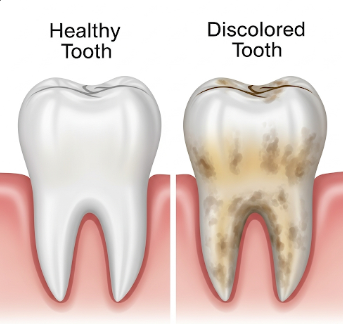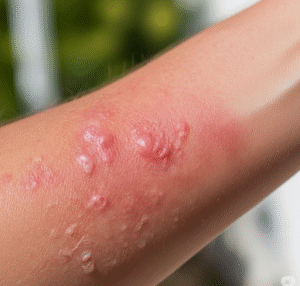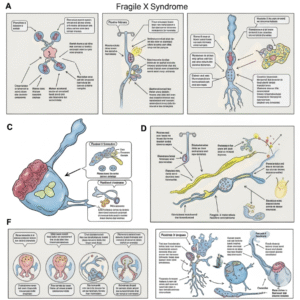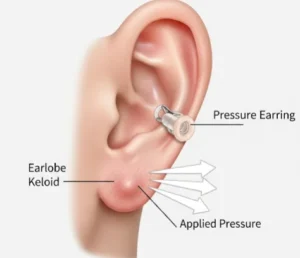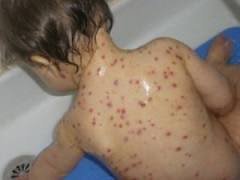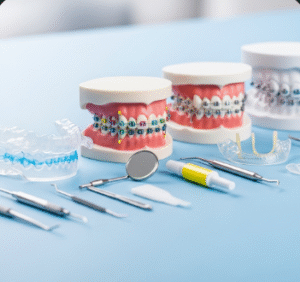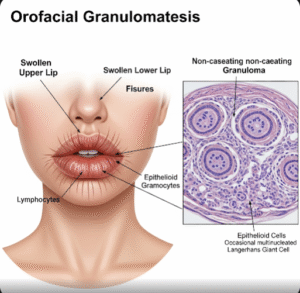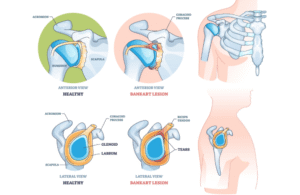➤ Overview
Tooth discoloration refers to a change in the natural color of teeth, ranging from yellowing to dark brown or black stains. While occasional discoloration is often cosmetic, persistent or sudden changes may indicate underlying dental or systemic health issues. Tooth color can be influenced by aging, diet, oral hygiene habits, medications, and trauma.
In South Korea, tooth discoloration is addressed by dentists and cosmetic dental specialists using both preventive and restorative approaches. Modern Korean dental clinics combine professional cleaning, whitening treatments, and advanced cosmetic procedures to restore natural tooth color while maintaining oral health.
➤ Key Facts
→ Healthy teeth are typically off-white with slight translucency.
→ Tooth discoloration may be extrinsic (surface stains) or intrinsic (internal changes in enamel or dentin).
→ Common causes include dietary factors, tobacco, medications, and aging.
→ Sudden or uneven discoloration may indicate decay, trauma, or systemic conditions.
→ In Korea, both preventive and cosmetic dentistry options are widely available.
→ Early detection can help prevent progression and restore aesthetics.
→ Maintaining proper oral hygiene is essential to prevent further staining or enamel damage.
➤ What is Tooth Discoloration?
Tooth discoloration is a visible alteration in tooth color resulting from changes in enamel, dentin, or the surface:
→ Extrinsic discoloration – Stains on the tooth surface from food, drink, or tobacco.
→ Intrinsic discoloration – Stains within the tooth due to medications, trauma, or developmental issues.
→ Age-related discoloration – Natural darkening of teeth with enamel thinning and dentin exposure.
→ Localized vs. generalized – Some teeth may be affected individually, while others show uniform discoloration.
→ Temporary vs. permanent – Some stains can be removed with cleaning, others may require restorative treatment.
In Korea, dentists evaluate tooth color using shade guides and digital imaging to determine the severity and appropriate treatment.
➤ What Symptoms are Related to Tooth Discoloration?
While tooth discoloration is primarily a visual concern, it may accompany other oral or systemic symptoms:
→ Tooth sensitivity → Pain or discomfort in response to hot, cold, or sweet stimuli.
→ Enamel erosion or wear → May indicate dietary acids or brushing habits.
→ Plaque or tartar buildup → Contributing to staining and gum irritation.
→ Tooth decay or cavities → Dark spots may signal underlying caries.
→ Bad breath (halitosis) → Often accompanies bacterial buildup on discolored teeth.
→ Gum inflammation → Red, swollen, or bleeding gums may coexist.
→ Changes after trauma → Teeth may darken due to pulp injury or internal bleeding.
→ Systemic signs – Yellowing of teeth may correlate with jaundice or liver issues.
➤ What Causes / Possible Causes?
Tooth discoloration can arise from various extrinsic, intrinsic, and systemic factors:
→ Extrinsic causes – Coffee, tea, red wine, tobacco, certain spices, or colored foods.
→ Intrinsic causes – Trauma, developmental enamel defects, tetracycline antibiotics during childhood, or fluorosis.
→ Aging – Enamel thins over time, exposing yellow dentin.
→ Medications – Certain antihistamines, antihypertensives, and chemotherapy drugs.
→ Dental restorations – Metal fillings or crowns may cause localized discoloration.
→ Poor oral hygiene – Plaque, tartar, and bacterial accumulation.
→ Systemic conditions – Liver or kidney disorders causing yellowing, or genetic conditions like amelogenesis imperfecta.
→ Excessive fluoride exposure – Dental fluorosis during tooth development.
➤ When Should I See My Doctor?
Evaluation by a dentist is recommended if tooth discoloration is:
→ Persistent or worsening despite hygiene.
→ Sudden or localized after trauma or infection.
→ Accompanied by pain, sensitivity, or decay.
→ Associated with systemic symptoms – Jaundice, unusual fatigue, or metabolic disorders.
→ Aesthetic concern – If discoloration affects confidence and social interactions.
→ In Korea, dentists provide comprehensive examination, diagnosis, and treatment planning for all types of discoloration.
➤ Care and Treatment
Treatment for tooth discoloration depends on the type and underlying cause:
→ Professional cleaning – Removes extrinsic stains and tartar.
→ Whitening treatments – In-office bleaching, laser-assisted whitening, or home-based trays.
→ Restorative procedures – Veneers, crowns, or composite bonding for intrinsic stains.
→ Fluoride therapy – Strengthens enamel and prevents further discoloration.
→ Oral hygiene optimization – Brushing, flossing, and regular dental check-ups.
→ Lifestyle modifications – Reducing consumption of staining foods, quitting smoking.
→ Monitoring systemic causes – Referral to specialists if discoloration signals underlying disease.
→ Trauma management – Pulp treatment or internal bleaching for injured teeth.
➤ Treatment Options in Korea
South Korea provides comprehensive dental services for tooth discoloration with advanced technology and cosmetic expertise:
Diagnosis in Korea
→ Clinical examination – Shade matching and visual assessment.
→ Digital imaging – High-resolution photographs and intraoral scans.
→ Dental X-rays – Evaluate underlying decay or trauma.
→ Medical evaluation – Blood tests if systemic causes are suspected.
Medical Treatments in Korea
→ Professional cleaning and polishing – Removes surface stains and tartar.
→ Bleaching treatments – In-office or take-home whitening kits under supervision.
→ Restorative treatments – Veneers, crowns, or composite bonding for intrinsic discoloration.
→ Oral hygiene counseling – Personalized guidance for prevention.
Advanced Therapies in Korea
→ Laser whitening and cosmetic procedures – Minimally invasive, effective, and safe.
→ Multidisciplinary care – Collaboration between cosmetic dentists, orthodontists, and ENT specialists if necessary.
→ Patient education programs – Promote long-term maintenance and aesthetic satisfaction.
Rehabilitation & Support in Korea
→ Regular dental check-ups – Monitor for recurrence of staining or enamel wear.
→ Guidance on diet and lifestyle – Prevent staining and maintain oral health.
→ Cosmetic follow-up – Ensure natural appearance and patient satisfaction.

